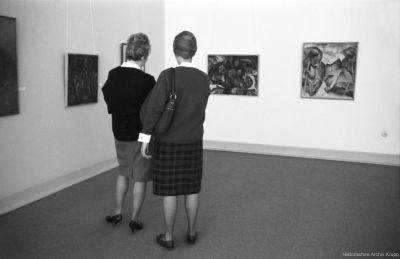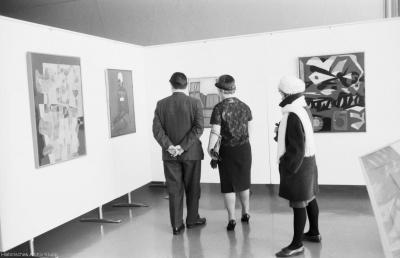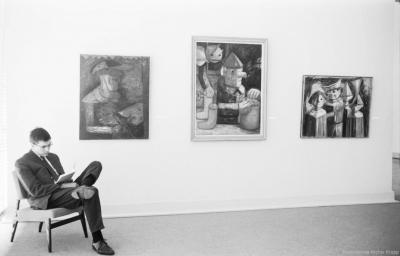Polnische Malerei vom Ausgang des 19. Jahrhunderts bis zur Gegenwart.

EXHIBITION PREPARATIONS
Documents on the exhibition in Essen are not only revealing from the point of view of contemporary history, they also question art-historiographical platitudes. In the catalogue on the 1994 Europa, Europa exhibition in the Bundeskunsthalle in Bonn, Christoph Brockhaus asked: “In the past decades what have we in the West witnessed of modern art from the East?”, to which he gave the following answer: “As a rule, and at their best, works weighed down with state support have left behind a bitter aftertaste rather than awakening our curiosity”, not forgetting exhibitions “that were presented more as a result of political and economic mediation than from expert justification” (vol. 1, p. 27). If this was the rule, then West German exhibitions of Polish contemporary art were constant exceptions. The Folkwang exhibition also demonstrated that state-sponsored art was not automatically state art, as Brockhaus suggests; and furthermore that “political and business mediation” and “expert justification” were not mutually exclusive. It was not only the stylistic diversity in the presentation of Polish contemporary art in Essen that challenged current perceptions of art from socialist countries, this was also the case with the genesis of the Essen exhibition, as is clear from the exhibition files in Warsaw and Essen. The show was jointly conceived by the Folkwang Museum and the National Museum in Warsaw; and the person chiefly responsible for compiling the exhibits was the Folkwang director, Heinz Köhn. This was not only the case with the overall concept but also with the selection of individual artists and works. Thus the exhibition can hardly be described as a propaganda show of the best achievements from the Polish state. Hence, in 1963 when the art critic Anna Klapheck wrote in her review that the exhibition was “sent on tour by official bodies” and showed Polish art “as these bodies would like to have it viewed in the West” (Freie Kunst aus Polen. „Polish Malerei“ im Essener Folkwangmuseum, Rheinische Post, 4.2.1963), this is at least only half the truth.
Heinz Köhn travelled on two occasions to Warsaw, in August 1961 and June 1962, in order to prepare the exhibition. From both stays he returned “with deep impressions and great delight” as he wrote to Lorentz on 29th June 1962 (AMNW). His letter summed up the results of his conversations with the curator Stefan Kozakiewicz and once again laid the foundations for his exhibition concept. The list of the works Köhn selected there has not survived but his suggestions with regard to the artists are quoted in a report in the AMNW. The comparison of these suggestions with the catalogue confirms that the exhibition was, as agreed, conceived in accordance with Köhn’s ideas. It was also Köhn’s wish not only to present an exhibition of contemporary art, as originally planned, but also works from the turn of the century and the classical Modern. Since Polish painting was “not sufficiently well-known” in the Federal Republic visitors would hence be able to get “a fuller and typical idea of the Polish painting in the 20th century” (ibid.).
The exhibition was mainly composed of works from the National Museum and correspondingly attempted to be a representative cross-section of the main waves in modern Polish art: from the postimpressionist style of someone like Olga Boznańska, via Władysław Strzemiński’s 1930s constructivism, all the way to a broad spectrum of abstract and figurative tendencies in contemporary art ranging from surrealism to the informal; there was even room for so-called “Socrealism”. Contemporary art was particularly represented by members of the re-founded “Grupa Krakowska” like Maria Jarema, Tadeusz Kantor, Alfred Lenica, Jerzy Nowosielski and Jonasz Stern, who already counted amongst the canon of Polish post-war avant-garde artists and were to become the embodiment of the cultural thaw. Some of them were already well known to an international audience as participants and prize-winners at the documenta and Venice Biennale, as well as being presented repeatedly at exhibitions in the Federal Republic in the early 1960s.
True, Köhn’s wish list had to be approved by several departments in the Polish Ministry of Culture and Art (MKS), but all in all the authorities seemed less interested in the contents of the exhibition as in the question of who would be responsible for the costs. The ministry would allow Lorentz and Kozakiewicz to travel to the Federal Republic (and also to the exhibition in other cities) provided that – alongside the guarantee that the works would be transported under the best possible conditions to ensure their preservation – the costs would be completely met by the German side (Lorentz to MKS, 6.11.1962, ANMW; MKS to Lorentz, 3.12.1962, ANMW). Köhn did not live to witness the exhibition himself. He fell ill in autumn 1962 and died two days after the opening. His representative and later successor, Paul Vogt, took care of the last stage of the preparations for the exhibition.




